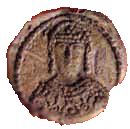Battle of Acheloos
| Battle of Achelous | |||||||
|---|---|---|---|---|---|---|---|
| Part of the Byzantine–Bulgarian Wars: War of 913–927 |
|||||||
 Seal of Simeon I |
|||||||
|
|||||||
| Belligerents | |||||||
| Bulgarian Empire | Byzantine Empire | ||||||
| Commanders and leaders | |||||||
| Simeon I of Bulgaria | Leo Phocas | ||||||
| Strength | |||||||
| 60,000 | 62,000 | ||||||
| Casualties and losses | |||||||
|
Unknown Light |
Massive 60,000 |
||||||
Coordinates: 42°38′35″N 27°38′12″E / 42.64306°N 27.63667°E
Unknown
Massive
The Battle of Achelous or Acheloos (Bulgarian: Битката при Ахелой, Greek: Μάχη του Αχελώου), also known as the Battle of Anchialus, took place on 20 August 917, on the Achelous river near the Bulgarian Black Sea coast, close to the fortress Tuthom (modern Pomorie) between Bulgarian and Byzantine forces. The Bulgarians obtained a decisive victory which not only secured the previous successes of Simeon I but made him de facto a ruler of the whole Balkan Peninsula excluding the well-protected Byzantine capital Constantinople and the Peloponnese.
The battle was one of the worst disasters ever to befall a Byzantine army, and conversely one of the greatest military successes of Bulgaria. Among the most significant consequences was the official recognition of the Imperial title of the Bulgarian monarchs, and the consequent affirmation of Bulgarian equality vis-à-vis Byzantium.
...
Wikipedia
